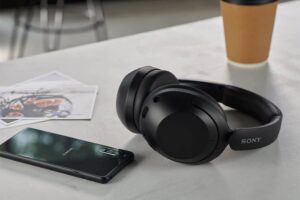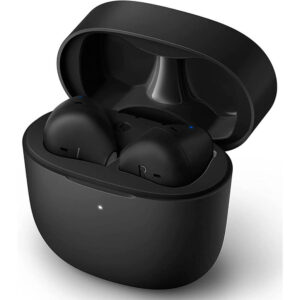A Comparison of the Advantages and Disadvantages of the Different Types of Headphones
The way we listen to music has changed significantly with each breakthrough in audio technology. Music was once a public display of one’s tastes thanks to boomboxes and blaring stereos. However, as headphones took over the market, music became a more private pastime. Until everyone’s Spotify Wrapped comes out, that is.
Today most people enjoy music with one of four different types of headphones: over-ear headphones, on-ear headphones, earbuds, and in-ear headphones. Let’s explore what each type of headphone has to offer to music listeners out there!
What All Types of Headphones Have in Common
Before we dive into their differences, let’s talk about what each style has in common.
All four headphone categories come in wired and wireless variants. Currently, wireless is the go-to standard for consumers. Also, you can find passive noise-canceling (PNC) options for all types of headphones. While active noise canceling (ANC) is available for over-ear, on-ear, and in-ear headphones.
And finally, all four can have convenience features, such as a microphone, volume controls, and smart assistant connectivity.
What’s the difference between earbuds and in-ear headphones?
To clarify, there is a difference between earbuds and in-ear headphones. Many people and websites use these terms interchangeably, but this article will use the following definitions:
Earbuds sit in the opening of your ear canal, called the concha. Depending on your ear shape and the model of the earbud, they may not offer a secure fit.
In-ear headphones have plastic or foam ear tips that are inserted into the ear canal. These create passive noise isolation, even with cheap headphones.
Related Post: Shopping Guide to Headphones
Comparing Each Type of Headphone
With those similarities and definitions out of the way, let’s discuss the advantages and disadvantages of each variant. Each headphone type offers unique and compelling advantages that separate them. No advantage or disadvantage is a “must have” or “deal breaker.” Use this list to compare the advantages and disadvantages of each type, so you can find the best fit for you.
Advantages & Disadvantages of Over-ear Headphones

Advantages
Overall Best Sound Quality
Over-ear headphones offer the best sound quality. Because of their size, these headphones typically come with larger drivers than the other kinds of headphones. The larger drivers offer more dynamic sound and much, much deeper bass than their smaller counterparts.
The over-ear design also makes it feel like the sound is around you. So they’re great for a spatial audio experience.
Not only that, over-ear headphones come in two variants, open-back and closed-back headphones. These variations completely change the acoustics of your audio. Open-back styles allow sound in and out, while closed-back styles are completely sealed around the ear cups. For more about the differences between them, SoundGuys has a quick blog about the topic.
If your purchase decision is largely driven by audio quality, over-ear headphones should be at the top of your list.
Active Noise Cancellation
To complement excellent sound quality, over-ear headphones have the widest variety of active noise-canceling (ANC) options. This feature effectively listens to and cancels out external noise so you can enjoy your music without distraction.
Cushioned for a Comfortable Fit
Over-ear headphones offer the best level of comfort for long listening sessions. Most are designed with soft ear cushions that make them comfortable to wear while creating a seal for noise isolation.
These, unlike in-ear and on-ear headphones, don’t put any pressure on your outer ear or ear canal, so you can enjoy music for hours. Some people report feeling toasty around their ears due to over-ear headphones being good insulators. If you use your headphones to workout, you may want to try another type if you’re worried about feeling hot around the ears.
Disadvantages
Size and Portability
The main disadvantage of over-ear headphones is their comparable lack of portability.
Due to their larger drivers and ear cups, these designs can be quite bulky. However, manufacturers design them to be foldable so they’re easy to carry around. Many models also come with a carrying case or carrying pouch to make transporting your headphones easier. And if you usually have a backpack or purse with you, then the bulk of over-ear headphones shouldn’t be much of a problem.
What Are Good Brands for Over-Ear Headphones?
Brands like Audio Technica, Sennheiser, Sony, JBL, and Bose offer premium over-ear headphones that are packed with premium features.
Check out our JBL Buying Guide
Try These Over-The-Ear Headphones:
Bose QuietComfort Ultra Wireless Active Noise Canceling Headphones
Advantages & Disadvantages of On-Ear Headphones

Advantages
Sound
Compared to in-ear headphones, they provide a fuller sound profile and better audio quality thanks to their larger drivers. In general, they offer the best audio quality for the size of their design.
With larger drivers, music will sound more dynamic by producing a wider range of mid and low frequencies, allowing listeners to physically feel the music.
What Are Headphone Drivers?
A driver, or electrodynamic speaker driver, is a component inside all headphones, it has the sole purpose of converting audio signals into usable sound.
Portability
Most on-ear headphones are foldable, have smaller ear cushions, and come with their own compact carrying case. They tend to save a lot of space compared to over-ear styles but are still larger than earbuds and in-ear headphones.
Comfort
The second key benefit to using on-ear headphones is the comfort they offer consumers who dislike the feel of in-ear headphones, or who feel hot around the ears when using bulkier over-ear headphones.
On-ear headphones avoid those disadvantages by resting on top of the ear; this location leaves your ear canal untouched and your head less thermally insulated. People experiencing both discomforts should take advantage of the balance offered by on-ear headphones.
Disadvantages
Discomfort
The main disadvantage of on-ear headphones is their placement on top of the outer ear. With the ear cups constantly applying pressure to the ear. The placement can be an advantage, but only for those who can’t stand the discomfort caused by in-ear and over-ear headphones.
On-ear headphones are reported to be problematic for long listening sessions; most consumers report feeling earaches after about an hour of usage. This doesn’t make on-ear headphones a deal breaker, and many become accustomed to the pressure, but this is something to keep in mind when comparing headphone styles.
Noise Isolation
When it comes to noise isolation, on-ear headphones offer the worst performance out of the four types. Being placed on top of the ear does not offer the best seal between the environment and your eardrum.
Even if your pair of headphones offers a good seal, part of your ear (mainly the back) is still exposed to the open air. With much of your ear lobe being exposed, sound can bleed through and reach your eardrum.
The Advantages & Disadvantages of Earbuds

Advantages
Cost
Earbuds start at a low entry level for casual or first-time music listeners. But there are plenty of brands that sport high-quality versions for more serious audiophiles.
Portability
Earbuds are just as portable as in-ear headphones. They’re ideal for carrying in your pocket, purse, or backpack. With a small footprint, earbuds can be stored anywhere on your person. This is a key advantage because carrying a pair of earbuds won’t be a second thought for most people.
Comfort
The main benefit of earbuds is they are more comfortable for people who dislike the feeling of in-ear headphones.
Disadvantages
Noise Isolation
Earbuds do not create a good seal between the ear canal and the open air. As a result, more sound from your environment will leak into your music. This can be a disadvantage for some, but if you prefer to hear what’s going on around you, then it might not be a bad thing.
Fit
Again, while it’s an advantage for some, many find that earbuds tend to fall out of their ears far too often. If you can find an earbud that fits well in your ears then it might not be an issue.
Sound Quality
The small drivers in earbuds lack the power to reproduce deep bass when compared to over- and on-ear headphones. Still, you can find high-quality earbuds that provide better sound quality than typical earbuds, but you will still find better sound profiles in larger headphones.
Durability
This is more of a problem for earbuds that still have wires, or are without true wireless. Wired earbuds can get snagged on objects, corners, and furniture–which yanks them out of your ears–causing more wear and tear for the entire unit.
Depending on how tough you are on your earbuds, the wired connection can degrade faster. Cheap wired earbuds will degrade especially fast. True wireless earbuds won’t have as much of a problem.
The Advantages & Disadvantages of In-Ear Headphones

Advantages
It is no secret that in-ear headphones are the most popular type of headphones, and there is a good reason for this.
Portability
In-ear headphones are the ultimate solution for portability. Not only that, but in-ear headphones often offer impressive sound for their size; the only thing they truly lack is bass.
Noise Isolation and Cancellation
Ignoring active noise canceling technology, in-ear headphones provide the best noise isolation compared to the other two types of headphones and earbuds. Since in-ear headphones have ear tips that are inserted into the ear canal, it makes it very difficult for outside noise to bleed through to your eardrum.
Noise isolation is critical to people because we use headphones to fully enjoy the music we love. To bring noise-canceling technology back into the equation, in-ear headphones offer great options for both ANC and PNC.
True Wireless
This relatively new technology has two key advantages, convenience and an included charging case.
The most obvious advantage is pure convenience. Most wireless Bluetooth earbuds previously needed a wire connecting the two earpieces. These Bluetooth in-ear headphones are still more convenient compared to wired versions, but that single wire still introduces minor inconveniences like snagging on objects or the inability to freely use one earbud without the other swinging around.
True wireless earbuds fix both of these issues by eliminating the wire. An additional benefit offered by truly wireless earbuds is the charging case, included with most models on the market. In this case, people have a place to safely store their earbuds and charge them while not in use. The charging case can also give you extended listening times before doing a full recharge.
Disadvantages
Durability
Wired in-ear headphones, like wired earbuds, experience a lot of wear and tear. Even Bluetooth models that have wires can get caught on objects and take damage. True wireless earbuds won’t have the same problem, but the more heavily they’re used, the faster they’ll wear down.
Limited Sound Profile
Focusing on audio quality, earbuds cost more for similar sound quality to their bigger counterparts, but they still lack bass. Cheap earbuds are everywhere: grocery stores, gas stations, and hotel lobbies; the issue is that compelling sound quality costs more for earbuds than headphones.
Even if you have a good pair of earbuds, the only thing they excel at are the highs or vocals. Everyone likes to feel the music, but earbuds just aren’t capable of producing compelling bass; they can produce some mids, but lows are out of the question. This isn’t to say that all earbuds have low-quality sound, but they lack range.
Try these true wireless headphones:
Conclusion: Which Type Of Headphones Is Best For You?
Selecting the right pair of headphones is a decision for the wearer. Audio is objective to the user, so what works for you won’t be the same for someone else.
Most people will choose in-ear headphones because they offer the best portability while still offering decent sound; for those who want to experience greater audio quality or avoid discomfort, take a look at the advantages and disadvantages of each type, know what feels comfortable, and consider your use case scenario.
All Headphone Types Compared
| Over-Ear Headphones | On-Ear Headphones |
| Ear cups that fully fit over the ears | More compact design |
| Passive noise cancellation | Smaller ear cups |
| Robust audio profile | Less thermally insulating |
| Larger size | Less expensive |
| Over-Ear Headphones | In-Ear Headphones |
| Audio is supra-aural, so the sound isn’t directly hitting your eardrum | The sound waves go directly to your eardrum |
| Much heavier | Much smaller, compact, and portable |
| Deep bass response and reproduction | More expensive ANC |
| Lacks deep bass profile |
| On-Ear Headphones | In-Ear Headphones |
| Less compact, but still highly portable | The most portable type of headphones |
| More audio leakage | Minimal sound leakage |
| Can put pressure on the ears | Strongest noise isolation options |
| Earbuds | Over-Ear Headphones |
| Small, portable, and lightweight | Best audio quality with a wide range of highs and lows |
| Less bass reproduction | Over-ear design can put pressure on the sides of your head |
| No pressure on the ear | Good passive noise isolation |
| Poor noise isolation |
| Earbuds | On-Ear Headphones |
| Lightweight | Best ratio of portability and audio quality |
| Poor bass reproduction | More audio leakage |
| No pressure on the outer ear | Better noise isolation |
| Earbud | In-Ear Headphones |
| Sits outside of the ear canal | Inserted into the ear canal, can be uncomfortable for some |
| Can be hard to find a good fit that stays in your ear | Fits snugly and does not fall out of the ear easily |
| Poor noise isolation | Great noise isolation |

One thought on “What Are The Different Types of Headphones?”
Comments are closed.